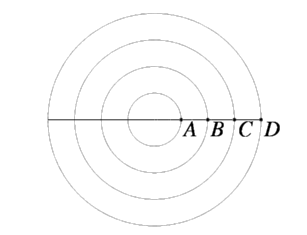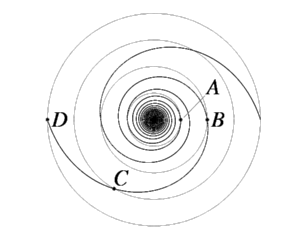Spiral Structure
Spiral arms come in different "flavors":
-
~10% grand-design (two
well-defined spiral arms)
-
~60% multiple-arm
-
~30% flocculent spirals
(no well-defined arms at all)
Spiral arms seem to be trailing
arms, but this is very hard to determine. In some rare cases,
spiral arms may lead.
Spiral arms are sites of strong
star formation: we see dust, HII regions, blue stars, lots of
gas. In fact, spiral arms are much more prominant in blue light than in
red. Here's a morphing movie of the spiral
galaxy M81 showing how the appearance of the spiral arms change with wavelength.
But what are they? How do they form? How long do
they last? |
|
Grand design Spiral:

|
Flocculent Spiral:

|
|
The Winding Problem
Spiral rotation curves are not"solid
body" rotation curves. What would a solid body rotation
curve look like?
Spiral rotation curves are flat: Vc ~ constant.
Therefore the angular rotation rate goes like
Vc/r, so that the outer edge takes longer to complete
an orbit than the inner regions.
So no solid arm could last very long -- it would quickly
get "wound up":
Start:
 |
Finish:
 |
Well, that's okay, it looks like a spiral pattern, what's
wrong with that? It happens too fast.
It happens in a few rotation periods (say, half a billion years). The age
of the Universe is something like 10-15 billion years -- if spirals made
their arms this way, they should all be so tightly wrapped we wouldn't
see them as spiral arms anymore!
So spiral arms can't be physical objects. What else could
they be?
Spiral Density Waves
Imagine driving down the freeway, and there are a couple
of grannies in their cars doing 40mph in both lanes. There's a big traffic
jam behind them.
You zoom up behind them doing 60 mph, then hit the jam.
You slow down to 40 and carefully work your way through the jam. Once you
pass the grannies you speed back up to 60 mph. Everybody else is doing
the same thing.
So we have a situation where the traffic jam moves along
at 40 mph, while the cars on the highway are typically going 60 mph. This
is an example of a density wave, a
density perturbation which moves along at a speed different from the speed
of the objects within it.
How does this apply to galaxies?
Imagine the spiral pattern is a density wave. It rotates
through the galaxy at a fixed angular speed,
called the pattern speed. In the inner
parts of the galaxies, stars are moving faster than the pattern speed,
and overtake the density wave (like you passing the grannies). In the outer
parts of the galaxies, stars move more slowly than the pattern speed, and
the spiral arms overtake the stars.
What happens when a star encounters the density wave?
-
As it nears the wave, it speeds up towards the density wave.
Why?
-
After it passes through the wave, it slows down and leaves
very slowly. Why?
-
So the star spends more time around the density wave than
it otherwise would. We see this as an enhanced density of stars -- a spiral
arm!
How does this help us with the winding problem?
This can't be the whole story, though. Why is there so
much more star formation in spiral arms?
One idea: as gas clouds
move into the density wave, the local mass density increases. Since the
criteria for cloud collapse ( the
Jeans instability) depends on density, a higher density makes it more
likely for clouds to collapse and form stars.
Another idea: as clouds
get swept up by the spiral arms, they collide with one another and drive
shock waves through the gas, which in turn causes the gas to collapse and
form stars.
But what causes the density wave???
Something has to "seed" this perturbation. Once it is seeded,
the self-gravity of the disk will amplify
the perturbation and make it grow.
Ideas:
-
Initial non-axisymmetry
in the disk and/or halo (ie galaxy formation processes)
-
Galaxy encounters (environmental
processes)
Here's an example of how an encounter between a big galaxy
and a small satellite companion can drive spiral structure:
Big mpeg movie
| Do we see this happening for real? Look at the
grand-design spiral galaxy M51:
In our own galaxy, the spiral arms may be excited by a
complex interaction between our companion galaxies the Large and Small
Magellenic Clouds, our dark matter halo, and the disk of our Galaxy. This
is not well understood, though.
|
 |




